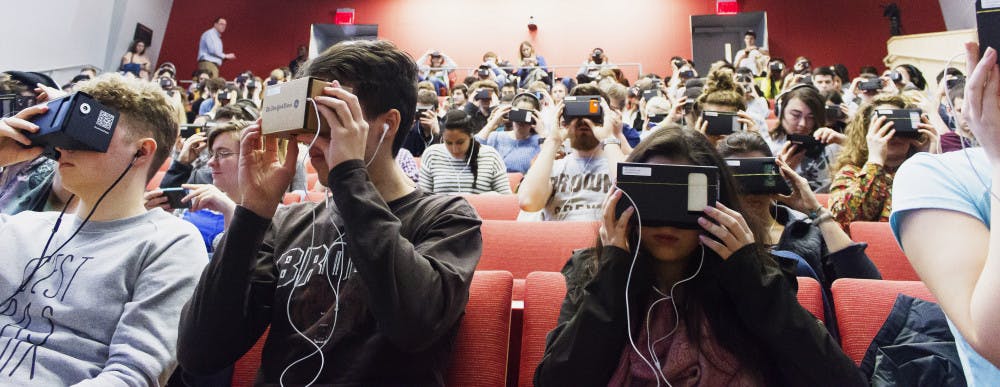Representatives from the New York Times Virtual Reality Team showcased their new immersive video technology at the Granoff Center for the Creative Arts Monday, presenting how the publication uses the media to both market products and serve as an educational tool.
Students in HIST0150D: “Refugees: A Twentieth Century History” had the opportunity to work with this technology Feb. 8 when the University provided each student with the Google Cardboard viewing apparatus, a simple smartphone holder that merges two images into a panorama. The class used the apparatus to watch “The Displaced,” a virtual reality video illustrating the struggles of three refugee children. The 11-minute video represents the first virtual reality film produced by the Times.
Vazira Zamindar, associate professor of history and co-director of South Asian studies, planned the exercise for the course with the hope it would provoke students to think critically about the refugee crisis and how the news media portray displaced people.
Zamindar said she expected her students to come to a variety of conclusions, but was “surprised by how consistent the responses were,” adding that the video is “manipulative” in how it guides viewers through the narrative.
Students, on the other hand, found the effect of the film more emotional than analytical — the most frequent word used to describe the experience in the post-class survey was “sad.”
“It was different than the emotional reaction from a film. You felt in the middle of it as opposed to being a spectator,” said John Irving ’16, a student in the class.
But the drawback of this emotional approach to storytelling is that background information may not be provided, as the focus is on the experience.
“‘The Displaced’ doesn’t tell the backstory, doesn’t tell you why they are in that situation,” said Sydney Levin, executive producer of the T Brand Studio, the native advertising department of the New York Times. Instead, “it is an experience, and we hope that experience becomes a memory,” she said.
Levin also sees virtual reality films as an opportunity to tell unbiased stories. Since the 360-degree camera cannot zoom in, and the panoramic footage can’t be significantly edited, “you can’t trick your viewers on what the story is,” she said.
Zamindar has a much more skeptical approach to this form of media. “The power of manipulation is enormous. There is a fine line between storytelling and selling,” she told The Herald, referring to the section of Levin’s talk regarding the use of virtual reality in advertising at the Times.
Other virtual reality films produced by the Times include sponsored content from Mini Cooper and General Electric.
Michael Villaseñor, creative director of innovation and marketing for the Times, addressed this gray area during the event.
He said that those working on virtual reality films often ask themselves, “How do you craft something that is as much an editorial piece and not just an empathy machine?”
The Times premiered its virtual reality app this November, so this technology is still in its infancy, Villaseñor said. “This is brand new territory we are venturing on.”
Beyond the actual media content, the act of viewing the videos in virtual reality can also be emotional.
The app encourages its users to wear headphones and view the video through Google Cardboard. This experience forces the viewer “to be completely focused on the subject,” Levin said.
The user is “alone with the content,” allowing them to “stop and feel something,” Levin said.
The physical experience, which requires viewers to hold Google Cardboard to their eyes for the duration of the film, becomes a limiting factor in the potential of virtual reality. Fatigue is a significant barrier to the development of longer, more in-depth virtual reality films, Villaseñor said.
Irving described the virtual experience as “not completely immersive,” but he said it does present a new perspective on storytelling.
“It makes you stand up, it makes you want to walk around — people were responding to it,” said Zamindar, who observed the experiment from the front of the auditorium.
The experience was “successful in the unstated goal to make students emotionally invested in learning about the issue,” Zamindar said. “But that wasn’t the goal going into it.”
That type of emotional response is something normal videos no longer produce in viewers, said Theodore Bogosian, visiting assistant professor in the practice of humanities and professor of HMAN 1971S: “Introduction to iPhone/iPad Moviemaking Using 3-D and 4K Comparisons,” who also moderated the event.
“There’s so much media in the world that people are becoming desensitized to motion pictures in a way that they never were before,” he said. Virtual reality, on the other hand, “increases empathy by lowering some of the barriers between you and the material.”
In regard to the potential of virtual reality in the classroom, Bogosian described Brown as an excellent environment for the technology. Brown professors are creative enough to present material in innovative ways. “It’s a matter of matching up a generation that’s adept at mobile device movie-making with the generation that has the intellectual experience,” he said. “Students have a lot to teach faculty about the ways smartphones can be used.”





